If you have your heart set on getting a German Shepherd, one of the things to consider is whether you’ll be able to take care of him. How easy it is to care for a German Shepherd is a noble question that helps you ensure that the dog you want will not get abandoned in the future.
Here are 10 easy ways how to care for a German Shepherd:
- Feed a nutritious diet.
- Housetrain your puppy.
- Socialize your German Shepherd.
- Sufficiently exercise your German Shepherd.
- Engage your German Shepherd with playtimes.
- Teach basic obedience.
- Provide a quality bed to prevent joint problems.
- Prevent separation anxiety.
- Care for your GSDs coat, teeth, ears, and nails.
- Maintain vaccinations, and flea and de-worming treatments.
This article will serve as your definitive guide to German Shepherd care. Here, you will learn exactly how to care for your GSD, whether you have a new puppy or an older dog adopted from a shelter. You’ll know what to do at each stage as we’ll cover each essential step in more detail.
Plus, we also have a daily care checklist for a German Shepherd at the end of the article.
So, if you want to know how to care for a German Shepherd, you’ve come to the right place. Let’s get started!
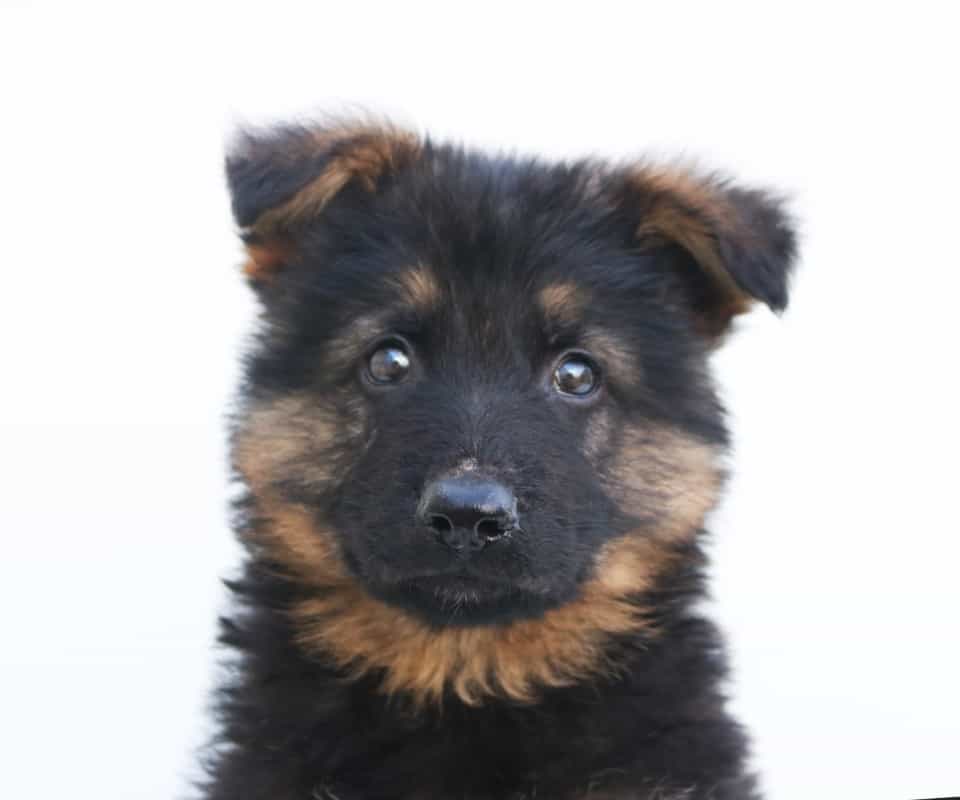
Are German Shepherds Easy to Take Care Of?
Since they are large and energetic dogs, you’re right to wonder if taking care of a German Shepherd is easy.
Although easy to train, taking care of a German Shepherd is no easy task as you’ll need to devote lots of time and energy, especially when the dog is a puppy. When caring for a GSD, you’ll need to consider physical activity, mental stimulation, proper crating, house training, and social experience.
All of these take time in the early days. However, as the puppy matures and reaches adulthood, looking after a German Shepherd gets a little easier. Nonetheless, a young adult will need around 2 hours of daily exercise.
So with that covered, it’s important to discuss if you’re a good fit for a German Shepherd.
Assess Whether You’re a Good Match for a German Shepherd
Can you take time out of your schedule to exercise your dog every day and brush him at least twice a week? If you can’t, is there someone in your family who can? Without anyone to fulfill this role, a German Shepherd will not be happy in your home no matter what kind of care you provide.
Asking yourself whether you’re truly ready for a big energetic dog is the most caring thing you can do for a German Shepherd.
You should only get a German Shepherd if:
- Your house has a backyard. Or you have enough space and enough dedication to take him on lots of walks to expend his pent-up energy.
- You have a family or regular company. German Shepherds mimic their owners, and if you are asocial, your dog might turn inwards and become aggressive to other people and pets.
- You have enough time to dedicate to your dog every day. If you leave him for extended periods every day, your dog will develop separation anxiety. Avoid getting a German Shepherd if you cannot be around him.
- You are an active person. If you enjoy outdoor activities, like walking or hiking, and love socializing, a German Shepherd will complement your life. More importantly, your new dog will be happier with you.
- You can afford their monthly expense. The cost of owning a GSD is expensive if you’re on a budget. Monthly costs for food, treats, vet fees, toys, etc., don’t come cheap. You’re looking at least $85 a month to keep a GSD. Prior to this, you have the initial costs of a crate, bed, leash, harness, travel crate, playpen, etc.
German Shepherds require consistency and care, which is fun to provide, especially when they’re in their prime. Looking after a German Shepherd isn’t difficult for active, fun-loving people who really care about their pets.
Learn How to Care for a GSD in Our YouTube Video…
How to Care for a German Shepherd
The most caring thing you can do for a German Shepherd is to avoid adopting him if you’re not prepared to take care of him properly. The section above covers that as the first step as there’s a chance that the breed might not be compatible with your lifestyle.
But if it is, then you will have a lot of fun and a fulfilling experience caring for your GSD.
To care for a German Shepherd, you must feed him a highly nutritious diet, exercise him daily for 1.5 to 2 hours, and socialize him so that he feels safe around humans and other dogs. Ongoing training, twice-weekly grooming, and vet check-ups are all part of caring for a GSD.
Now let’s look at the different steps of looking after a German Shepherd, one by one.
1. Feed Your GSD a Nutritious Diet
German Shepherds require a nutritious diet to maintain good health and promote longevity. An adult dog needs to be fed twice per day to discourage bloat and ensure proper digestion, whereas a growing puppy will need feeding 3-4 times a day at regular intervals.
Your dog will need 1,740 to 2,100 calories per day depending on his weight. However, these nutritional requirements can vary by the dog’s age and physical activity levels.
If you adopt a senior German Shepherd, he will need only 1,540 calories at a weight of 90 lbs. Senior German Shepherd food has lower calories and is easier on the dog’s teeth. However, in most cases, owners looking for a guide to care for a German Shepherd have adopted a younger puppy.
Regardless of your dog’s age, you must avoid feeding him on a diet of leftovers. More importantly, leftovers are inconsistent in their nutritional value, which is bad for your dog’s health and development. This UK study found that one disorder of GSDs recorded by vets included obesity, alongside joint issues and arthritis.
If you’re feeding dry food, ensure you choose food for large breeds. I prefer going with breed-specific products made by trusted brands.
Breed-specific dog food such as Royal Canin German Shepherd Puppy is a good option. It is a dry food product formulated to meet the nutritional needs of German Shepherd puppies up to 15 months old, and the kibble has a unique shape suited to the breed’s long muzzle. You can then switch to the adult variety.
Do you want to learn all about the best diet for German Shepherds? Check out this detailed post which includes nutritional requirements, info on the many different types of dog foods, and exactly what they can and can’t eat; Best Diet for German Shepherds.
2. House Train Your German Shepherd
As soon as you bring home your new German Shepherd, you’ll need to take him out at least every two hours so he can relieve himself. This is good because it allows you to anchor the command and familiarize your dog with the norm of going outside to go potty.
Fortunately, this schedule doesn’t persist for long. As your pup’s bladder and bowel controls become stronger, you can add an hour at a time between the intervals, and he will learn to hold his pee for longer.
German Shepherds will usually be fully house trained by six months and may only need to pee every 4-5 hours.
I also advise crate training as it helps to speed up potty training as puppies don’t like to mess inside their crate. Choose a size 48″ crate and use a divider.
Choose something like the Midwest Homes for Pets iCrate from Amazon. I like this crate as it comes with a free divider and an easy-to-clean removable tray, so you’ve nothing else to buy. It also has the option of single or double doors.
3. Socialize Your German Shepherd
When caring for a new German Shepherd, the most critical factor in the quality of your dog’s life following his health is his social experience. You might have heard the sayings, “a dog is a man’s best friend,” and “humans are social animals.” The two are related because our relationship with dogs is based on our social compatibility.
An asocial dog is a wolf to our subconscious. If you don’t want your German Shepherd to put people on edge, receive fewer pats and compliments, and have zero canine friends, you have to start socializing him as soon as you get him.
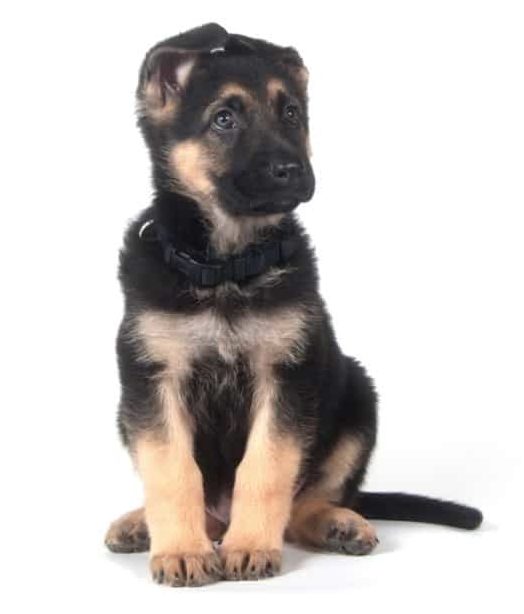
Stage One: Curious Puppy
When you bring home a German Shepherd, he is equally parts curious and confused. Your job is to promote curiosity by encouraging him to follow you around. Have tempting treats just around the corner. Egg him on to follow you by danging attractive playable objects like a tug rope.
This is also a good time to start bringing home objects that the puppy is likely to witness outdoors. This builds a bridge of familiarity between the outdoors and the indoors. I expand upon this in a separate article dedicated to socialization, Easy Ways To Socialize a German Shepherd.
Stage Two: Human Exposure
When your GSD is still a puppy, he is in the process of anchoring finding out what is normal. If you expose him to other humans during this period, including children, he becomes friendly. A German Shepherd exposed to humans at a young age is less anxious and gets treated better as a consequence.
Some new dog owners make the mistake of waiting until their puppy is grown enough to go on walks then take them to meet people. By then, the pup has already built an idea of an in-group and sees all strangers as the out-group.
You should carry your puppy and get him to experience different sights, sounds, smells, and noises as soon as you get him. Have friends and family pet him before he develops a biting reflex. With enough positive exposure during this stage, your pup will likely see human presence as a good thing.
Stage Three: Other Dogs
Your friends will want your new puppy to visit. But if you haven’t socialized him with other dogs, he might snap at them and leave your previously enthusiastic friends traumatized. To socialize your German Shepherd with other dogs, you need to reward him for being quiet and calm around them.
Before full immunization, carry him to the dog park and let him observe the other dogs. Once he’s had his shots, slowly introduce him to a friendly dog one at a time. Reward him for good behavior and speak calmly and with praise. Remove him from the situation if he growls or barks, and calm him down. Once he is calm, try again.
4. Sufficiently Exercise Your German Shepherd
Young German Shepherds are very energetic, and if they do not get a productive outlet to release their excess energy, they can become destructive. To avoid scratched furniture and chewed-up rugs, you should exercise your GSD sufficiently for his age. An adult dog will need around 2 hours of daily exercise.
As a rough guide, a German Shepherd puppy needs 5 minutes of exercise (twice a day) for every month of age. So, an 8-week-old puppy can exercise for 10 minutes twice daily, while a three-month-old can exercise for 15 minutes twice daily. Follow this rule until the puppy is fully grown.
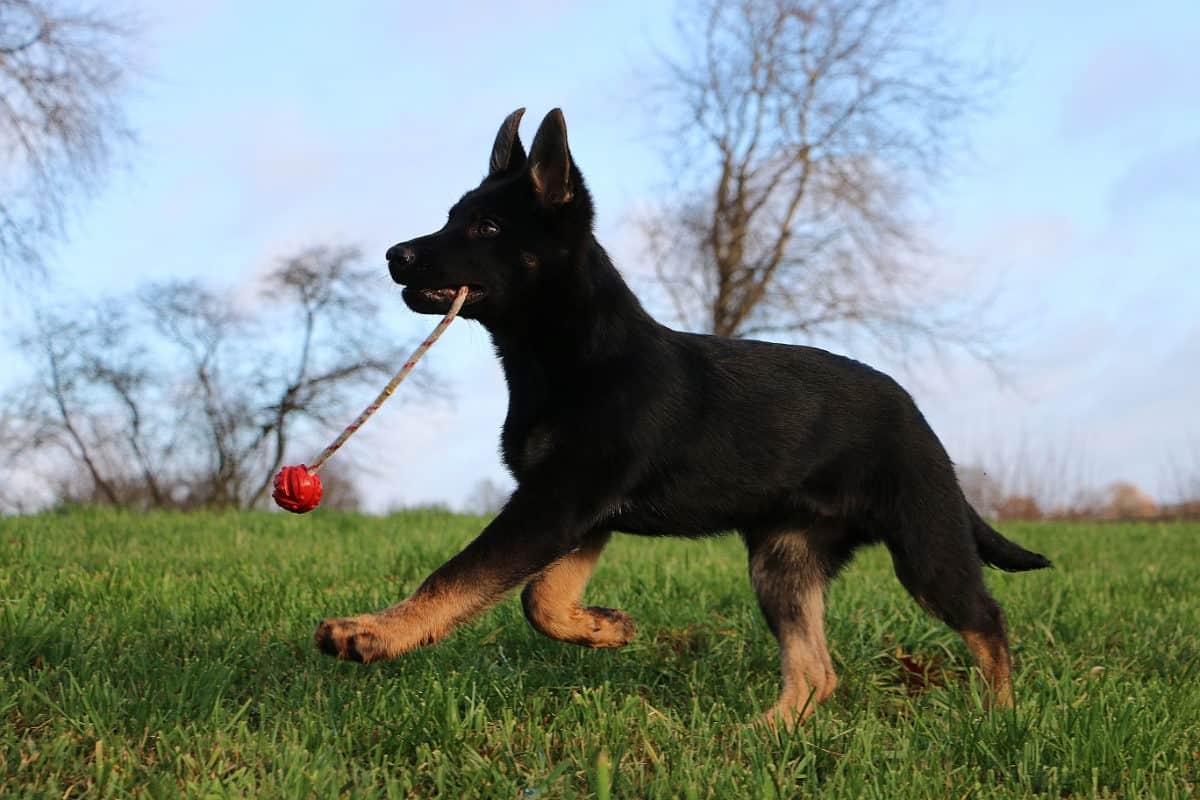
Common mistakes to avoid when exercising the dog are:
- Taking a dog on walks outside before he is fully vaccinated – A puppy should not be taken out for walks until 2 weeks after the final vaccinations which are usually given between weeks 10-12.
- Letting the German Shepherd jump too early – Exercising a German Shepherd puppy entails being careful not to damage his growth plates. They can safely jump after they are fully grown at 18 months old.
- Walking the dog until he is exhausted – While you should let your German Shepherd exhaust his energy during daily walks, don’t forget to include the distance to get back home.
- Confining exercise to walks only – While a walk accounts for a bulk of your German Shepherd’s exercise requirements, you need to exercise his joints, muscles, and mind as well.
- Not making exercise fun – If you treat exercise as simply that, your German Shepherd will not have fun. He can pick up on your mood, so you should make exercising enjoyable for you both.
Mental exercise is easier to turn into a fun routine. From training a GSD to do party tricks to giving him fun puzzles to solve, there are many fun ways to provide mental stimulation for your German Shepherd. When your dog is bored, he might start bothering you by engaging in destructive attention-seeking behaviors.
Toys like the Outward Hound Dog Treat Puzzle from Amazon engage your dog’s mind. GSDs are among the smartest dog breeds, with the average dog being as intelligent as a two-year-old human. This puzzle doubles as a treat dispenser, which automates the reward mechanism.
What I like about this specific product is that it comes in different levels of difficulty. With levels 1 through 4 produced by the same brand, you can reliably amp up the challenge level as your German Shepherd gets smarter.
You can check out this article for some great tips on how to exercise your pup, 7 Fun Ways to Exercise a German Shepherd Puppy.
5. Engage Your German Shepherd With Playtimes
German Shepherds’ playtime and exercise can overlap. During playtimes, you and your doggo are engaged in low-effort, enjoyable activities. Games are the bridge joining mental and physical exercise to constitute play.
Here are some of the games you can play with your German Shepherd:
- Fetch – This is good for building rapport between you and your dog, improving his response time, and conditioning him for obedience.
- Hide and Seek – Playing hide and seek with your dog also improves his tracking skills. You train your dog to pick up a scent and follow clues. GSDs are smart enough to catch up, so you’ll need to keep finding new places to hide.
- Tug of war – Playing tug of war with your German Shepherd can be a lot of fun. However, as your dog grows, you might find the game challenging once he is 90 lbs! So, bear this in mind if you play this game with your young pup.
- Cups and treats – This is a game where cups are turned upside down, and a treat is hidden underneath one cup. You quickly shuffle the cups changing their position, and the GSD gets a treat for pointing out the right one.
6. Teach Your GSD Basic Obedience
While exercise is an essential requirement of German Shepherd care, he must first learn to obey you because, in the absence of this, you will not be able to train him to do anything. The basic training method for German Shepherds involves patience, reward, and an anchor. My article on how to train a German Shepherd details exactly how to do this, but here’s how it goes:
- Wait for the young puppy to do something (walk, run, sit, etc.).
- Say the word you want to associate with the action (“COME,” “SIT,” “DOWN,” etc.).
- Give him a treat as a reward for performing the right behavior.
When you do this repeatedly, he will associate the word with the action. Next time you say “COME,” he will come to you. Treats will reinforce the anchor command perpetually. You can use this method to train the dog to exercise and engage in different games.
7. Provide a Quality Bed to Prevent Joint Conditions
German Shepherds aren’t too picky about their sleep, as you’ll notice as soon as you bring your puppy home. During the first month, he’ll have an average worker’s Monday morning mood.
As he grows older, his sleep pattern will change, but he’ll still be able to sleep anywhere you place his dog bed. When caring for your German Shepherd you must be mindful of the bed quality. German Shepherds grow large and are susceptible to arthritis, hip dysplasia, and other joint conditions.
Unfortunately, they can get joint pain from a standard or poor-quality dog bed. So, if you want longevity for your best friend, it’s best to get an orthopedic dog bed to help prevent these issues in the first place.
My German Shepherd uses the Big Barker Orthopedic Bed. This is the only bed clinically proven by scientists to reduce pain and improve mobility in big dogs with arthritis. As the owner of a German Shepherd with osteoarthritis of the spine, I also chose this bed due to its cool 10-year “no-flatten” guarantee. You can read my latest review of the Big Barker here.
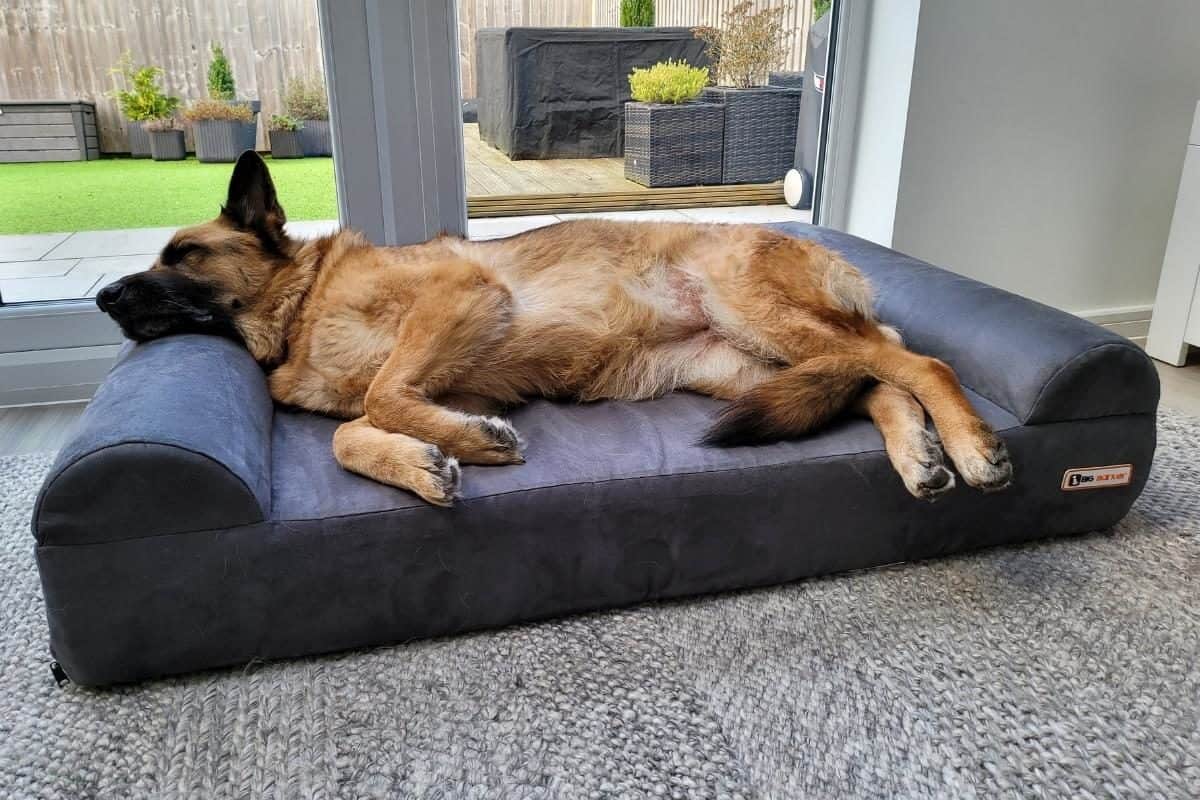
8. Prevent Separation Anxiety
Medical issues aren’t always physical. Your dog’s mental health is important, so you should make sure you give him enough company as well as alone time. Among the two, your GSD prefers to err on the side of company.
Separation-related behavior (SRB) only happens when a dog is separated from its owner and becomes distressed and shows behavior problems. The dog simply cannot cope with separation and loneliness and frets that when you’re gone, you’ll never return.
Avoid separation for long periods and take steps to offset trust issues if you notice your dog getting too anxious. Don’t leave a German Shepherd alone for more than four hours, and even less for young puppies. If you are going out for longer or regularly work long hours, you’ll need to care for your dog by other means.
Some things you can do are:
- Arrange friends and family to call around.
- Get a dog sitter.
- Use a dog walker.
- Take your pup to doggy daycare.
- Work from home.
- Call home during your lunch break.
- Work flexi-time.
Having a mix of these options on different days is a great solution, and your pup will soon get used to his routine.
Do you want to learn all about canine separation anxiety? Check out this detailed post, German Shepherd Separation Anxiety. You’ll learn why the breed is prone to this psychological condition and how to prevent it.
9. Care For Your GSDs Coat, Teeth, Ears, and Nails
A German Shepherd’s coat is predominantly thick with two layers of fur. The guard coat protects the dog from the elements such as UV rays and rain, whereas the undercoat protects the skin and keeps them warm in winter and cool in summer.
German Shepherds are not hypoallergenic but are a heavy shedding breed – and that means you’ll need to care for his coat.
Read More: German Shepherd Shedding: Causes, Season and Solutions.
To care for your German Shepherd’s coat, you’ll need to brush his fur at least twice per week and facilitate de-shedding. Brushing will need to be increased in the heavy shedding seasons during fall and spring when they “blow” their undercoat.
Get a suitable grooming tool to help with de-shedding. I use the FURminator undercoat de-shedding tool from Amazon. It does a great job of safely reaching through the guard coat to remove all the loose and dead undercoat. Despite trying other tools, this one serves me well.
You’ll also need to periodically wipe your German Shepherd’s ears clean, brush his teeth, trim his nails and bathe him 2-3 times a year.
10. Maintain Vaccinations, Flea and De-worming Treatments
Vaccinations
Your German Shepherd will need to complete his immunization within 12 weeks. Follow your vet’s guidelines and make sure to schedule regular check-ups. A good idea is to arrange a new puppy check-up with your vet within the first few days of getting him. Have him weighed and checked over.
I used to have my German Shepherd puppy weighed monthly at the vets. For weight and height charts, check out this article, When Do German Shepherds Stop Growing to check your pups’ development.
De-worming and Flea Prevention
Deworming and flea prevention treatments are frequently required to prevent disease and flea or tick infestations. Worm control in dogs is even more important today due to climatic changes and increased pet travel, especially in Europe.
Willow’s treatments protect her for three months, but she had monthly treatments as a puppy. You’ll need to check with your vet and follow the best advice for your pup.
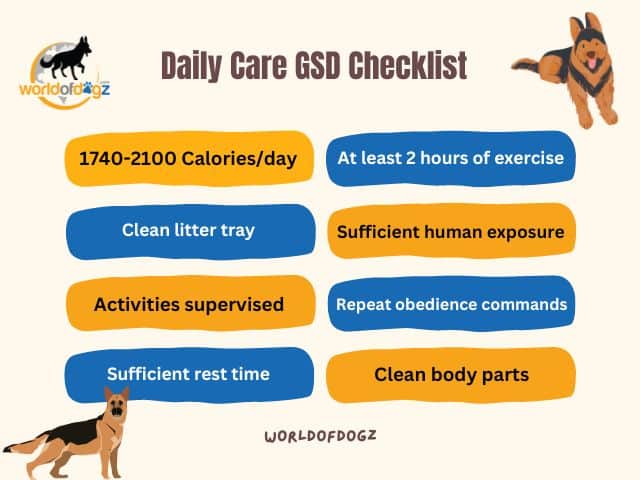
Final Thoughts
Caring for a German Shepherd isn’t hard if you’re willing to put in the time and effort. It can initially seem overwhelming to see everything you need to do, but it becomes a walk in the park when you do them one at a time.





